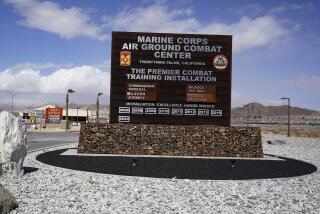749 Americans Died in Disastrous 1944 Exercise in England : Army to Honor GIs Killed in D-Day Rehearsal
- Share via
SLAPTON SANDS, England — The U.S. Army today will honor 749 World War II American soldiers killed in a disastrous rehearsal for the D-Day invasion that turned into chaos when commanders, without informing the troops, decided to use live ammunition to lend realism to the exercise.
In what became known as “The Night of the Bloody Tiger,” scores of soldiers were shot by comrades who thought they were firing blanks. Others, weighted down by combat gear, drowned. Still others sank beneath the waters because they had not been instructed in the proper use of life preservers.
A mix-up in communications enabled German torpedo boats from occupied France to slip in among the vessels participating in the exercise and sink two U.S. landing craft and damage a third, according to historians. A fourth landing craft was hit in cross-fire between another American ship and the German boats.
There is still controversy over how many soldiers and sailors perished. And nothing was done until now to commemorate their sacrifice.
Charles B. MacDonald, a former U.S. Army historian, was called out of retirement to research the exercise. He told a news conference Saturday that he believes the death toll was 946--749 soldiers plus 197 seamen overlooked earlier.
The disaster during the exercise held off southern England, code-named Operation Tiger, led to a U.S. Army cover-up that suppressed the tragedy for years. The full catalogue of blunders only become known during preparations to mark the 40th anniversary of D-Day on June 6, 1984.
No one was ever court-martialed in the disaster, but one admiral later committed suicide and others were quietly replaced, British press reports said.
Officers from the U.S. Army and area residents will gather today on a beach in Slapton, 150 miles southwest of London, to remember the GIs killed in the disaster and dedicate a memorial in their honor--the first official U.S. Army homage to the victims.
U.S. Army troops had moved into 30,000 acres of southern England and evacuated villages, including Slapton, during the first six months of 1944. The soldiers were to be trained in beach landings until they were ready to storm Adolf Hitler’s Fortress Europe at a top-secret location on an appointed “D-Day,” historians said.
Several massive beach landing rehearsals were staged on England’s Devon coast. The largest, Operation Tiger, was scheduled for April 23, according to historical accounts of the disaster.
The crescent-shaped beach at Slapton Sands was chosen because it resembled Utah Beach on France’s Normandy coast where the American D-Day landings were planned. On D-Day, 179 GIs were killed at Utah Beach--570 less than the number killed in the exercise.
Many of the troops, fresh from the United States, had never experienced combat. Commanders decided to use live ammunition for better training but did not tell the soldiers, historians said.
Real explosions during the exercise led to panic, and landing craft began firing on each other. Soldiers were shot to death with guns they thought had been loaded only with blanks, the accounts said.
A destroyer acting as the main escort of the training flotilla was rammed by another vessel and ordered to withdraw. The move enabled German torpedo boats to slip in among the U.S. ships.
They were detected by Britain’s Royal Air Force, which informed the Royal Navy, but the information never reached the U.S. Army, historians said.
“The sea was on fire,” a survivor, Manny Rubin, then a 21-year-old Navy signalman on one of the landing craft, recalled Saturday. “It was a dreadful sight. It was just a slaughter, really.”
Following the disaster, the U.S. Army used a cover-up, first to avoid undermining morale and later to hide embarrassment over the incident, historians said. Families were told the GIs had been killed in the line of duty.
The U.S. Army said it buried the dead in temporary graves, but it has never disclosed whether the bodies were later moved.
Local residents--including Ken Small, a hotel owner who has spent more than $29,000 to recover a sunken battle tank from the water to serve as a memorial for the American GIs--say the 749 remain in secret graves near Slapton.
More to Read
Sign up for Essential California
The most important California stories and recommendations in your inbox every morning.
You may occasionally receive promotional content from the Los Angeles Times.













